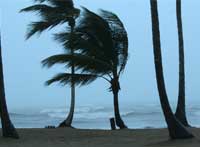Offshore hurricane insurance sees poor take up rate in 2009
 In Autumn 2008, after Hurricane Ike, many energy professionals doubted whether a sustainable product could be offered or whether capital providers would provide the necessary capacity. Ike had followed close on the heels of hurricanes Ivan, Katrina and Rita, which had led many insurers to retreat from the class. It became difficult to purchase reinsurance for windstorm and those that could often moved away from excess of loss to quota share.
In Autumn 2008, after Hurricane Ike, many energy professionals doubted whether a sustainable product could be offered or whether capital providers would provide the necessary capacity. Ike had followed close on the heels of hurricanes Ivan, Katrina and Rita, which had led many insurers to retreat from the class. It became difficult to purchase reinsurance for windstorm and those that could often moved away from excess of loss to quota share.
The aftermath
Lloyd’s Syndicates and insurers like Berkshire Hathaway, continued to offer hurricane products. Most of the products required a sizeable deductible based on a percentage of exposed assets and offered a policy aggregate limit, which was calculated as a percentage of exposed values. Premium was based on a rate on limit calculation, originally as high as 20%. It was sometimes difficult for smaller operators and contractors to buy coverage that corresponded to their largest single exposure. Coverage could be purchased alongside cover for other perils or stand-alone. The Berkshire product however provided a larger aggregate limit, shared by all the participants in the scheme.
Take up for the Lloyd’s style product was probably around 50% among oil companies but less among drilling contractors. Some declining clients continued to buy conventional insurance for other perils, but others decided not to buy anything, finding the product expensive at a time of low oil prices and profits. The Berkshire product, whilst offering a welcome idea did not take off.
Other opinions
I was unsure that this scenario offered much optimism for the future, but this week I spoke to four leading energy underwriters about hurricane risks, one of whom will not participate in future because his company feels that, with no reinsurance, the potential risk was unacceptable. He also felt that, with investment returns being poor, he needed to concentrate on traditionally profitable business areas. Nevertheless, he believed that there is a future for hurricane insurance.
Other insurers spoke with varying degrees of optimism about a continuing hurricane product. Some underwriters told me that they had come respectably close to achieving their capacity and premium targets. Reassuringly two underwriters mentioned continued efforts to improve their products by providing more attractive limits and creative ideas, like the provision of a larger aggregate limit over a longer period.
Conclusion
All were keen to try to coax back some of the clients that had been lost and at least two underwriters conceded there would be pressure on pricing if 2009 was windstorm free. All stressed the need to achieve a suitable premium volume against realistic disaster scenario projections, though all conceded that the RDS tool was somewhat flawed. All observed that the withdrawal of some insurers from the windstorm market and low take up of windstorm products puts rating pressure on other geographical areas and risks.
Author: Peter Portman, Partner, Energy & Marine Group, Jardine Lloyd Thompson Ltd.
Read the article online at: https://www.oilfieldtechnology.com/drilling-and-production/30092009/offshore_hurricane_insurance_sees_poor_take_up_rate_in_2009-/
You might also like
tengizchevroil starts WPMP operations at tengiz oil field in Kazakhstan
Chevron has announced today that its 50 % owned affiliate Tengizchevroil LLP (TCO) has safely commenced operations at its wellhead pressure management project (WPMP) at the Tengiz oil field in Kazakhstan.

